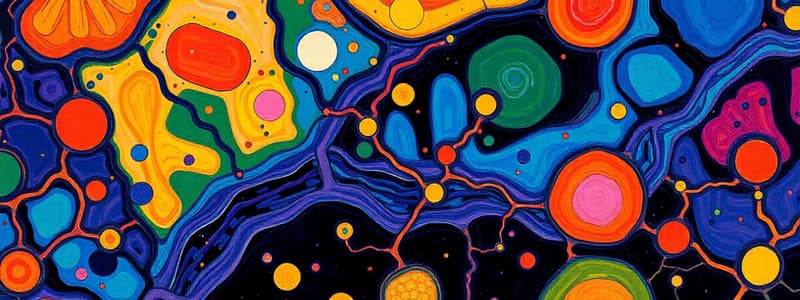Podcast
Questions and Answers
What is the primary function of connective tissue?
What is the primary function of connective tissue?
- Producing hormones and enzymes
- Connecting other tissues or organs together (correct)
- Transporting nutrients and waste
- Protection of internal organs
Which component of connective tissue is described as being widely separated?
Which component of connective tissue is described as being widely separated?
- Epithelium
- Fibers
- Matrix
- Cells (correct)
Which of the following is NOT a property of connective tissue?
Which of the following is NOT a property of connective tissue?
- Polarity
- Cellularity
- Attachment to a basement membrane (correct)
- Regeneration
What is the main structural component of collagen fibers?
What is the main structural component of collagen fibers?
How are connective tissues primarily classified?
How are connective tissues primarily classified?
What distinguishes connective tissues from epithelial tissues?
What distinguishes connective tissues from epithelial tissues?
Which type of connective tissue fiber provides great tensile strength?
Which type of connective tissue fiber provides great tensile strength?
Which of the following statements about the cells in connective tissue is true?
Which of the following statements about the cells in connective tissue is true?
What is the primary function of cartilage in the body?
What is the primary function of cartilage in the body?
Which type of connective tissue is considered the hardest?
Which type of connective tissue is considered the hardest?
What cells are primarily responsible for the maintenance of cartilage?
What cells are primarily responsible for the maintenance of cartilage?
How is the extracellular matrix of bone primarily characterized?
How is the extracellular matrix of bone primarily characterized?
What type of connective tissue transports nutrients and waste products throughout the body?
What type of connective tissue transports nutrients and waste products throughout the body?
Which structure within bone serves as a passage for neurovasculature?
Which structure within bone serves as a passage for neurovasculature?
Which type of blood cells are involved in the defense against microorganisms?
Which type of blood cells are involved in the defense against microorganisms?
What is a primary component of the extracellular matrix (ECM) in cartilage?
What is a primary component of the extracellular matrix (ECM) in cartilage?
What is the primary protein found in elastic fibers?
What is the primary protein found in elastic fibers?
Which connective tissue is primarily responsible for energy storage?
Which connective tissue is primarily responsible for energy storage?
What type of fibers predominates in fibrous connective tissue?
What type of fibers predominates in fibrous connective tissue?
What is one of the main functions of connective tissue proper?
What is one of the main functions of connective tissue proper?
Which types of cells are primarily found in areolar connective tissue?
Which types of cells are primarily found in areolar connective tissue?
What type of fibers are predominant in reticular connective tissue?
What type of fibers are predominant in reticular connective tissue?
Which of the following correctly defines the composition of adipose connective tissue?
Which of the following correctly defines the composition of adipose connective tissue?
Where is reticular connective tissue primarily found?
Where is reticular connective tissue primarily found?
Flashcards are hidden until you start studying
Study Notes
Connective Tissue
- Connective tissue connects other tissues or organs to support them and consists of cells surrounded by a fluid called the extracellular matrix (ECM).
- Connective tissue cells are loosely packed within the ECM.
- Connective tissue has a significant amount of intercellular substance or matrix.
Components of Connective Tissue
- Cells: These are widely separated within the ECM.
- Fibers: These include collagen, elastic, and reticular fibers.
- Matrix: This is an amorphous ground substance.
Properties of Connective Tissue
- Cellularity: Cells are relatively few in connective tissue and are separated by a prominent intercellular substance (Matrix).
- Polarity: Cells are scattered within the matrix, so there is no polarity.
- Attachment: Cells don't rest on a basement membrane.
- Vascularity: Connective tissue is well vascularized.
- Regeneration: Connective tissue contains mesenchymal stem cells.
Classification of Connective Tissue
- Connective tissues are classified based on the characteristics of their ground substance (solid or fluid) and the types of fibers present within the matrix.
Fibers of Connective Tissue
- Collagen Fiber: Provides strength and rigidity to tissues; it is flexible but has great tensile strength.
- Elastic Fiber: Can be stretched to 150% of its resting length and returns to its original shape.
- Reticular Fiber: Thin, delicate fibers that form meshwork networks in organs like the spleen, kidneys, and lymph nodes, providing structural support to parenchyma.
Connective Tissue Proper
- Connective tissue proper is found between organs and acts to absorb shock and bind tissues together. It allows water, salts, and nutrients to diffuse.
Areolar Connective Tissue
- Characterized by an almost equal amount of cells, fibers, and ground substance.
- Chief cells are fibroblasts, but immune system cells are also present.
- Collagen fibers are the principal fibers of the ECM, loosely scattered.
- Moderate amounts of reticular and elastic fibers are present.
Adipose Connective Tissue
- Energy-storing connective tissue composed of adipocytes (cells filled with lipids).
- Contains a small amount of ECM with only a few collagen fibers.
- Classified as white or brown adipose tissue based on lipid distribution within the cell.
Reticular Connective Tissue
- A mesh-like supportive framework for soft organs like lymphatic tissue, the spleen, and the liver.
- Reticular cells are its chief cells.
- Composed of reticular fibers organized in delicate networks.
Fibrous Connective Tissue
- Primarily composed of fibroblasts.
- Collagen fibers are predominant, and elastic fibers are few.
Skeletal Tissue
- Skeletal tissue consists of cartilage and bone, which maintain posture and protect internal organs.
Cartilage
- Avascular connective tissue connecting bones at joints and making up the walls of the upper respiratory airways and external ear.
- Chief cells are chondrocytes, found within cavities in the ECM called lacunae.
- The ECM is extensive, rich in water bound to glycosaminoglycans.
- Cartilage's flexibility is due to the ECM, which is resilient to mechanical stress.
Bone
- The hardest connective tissue, providing protection to internal organs and supporting the body.
- Consists of cells within an extracellular matrix of fibers (predominantly collagen fibers) and ground substance.
- The extracellular bone matrix is mineralized and arranged in circular layers called lamellae, surrounding a central canal (Haversian canal) that serves for neurovascular passage and houses cells.
- Bone's rigid extracellular matrix contains collagen fibers embedded in a mineralized ground substance containing calcium phosphate.
Vascular Tissue
- Blood and lymph are fluid connective tissues.
- Cells circulate in a liquid extracellular matrix (Plasma).
- Erythrocytes (red blood cells): Transport oxygen and some carbon dioxide.
- Leukocytes (white blood cells): Defend against microorganisms or molecules.
- Platelets: Cell fragments involved in blood clotting.
- Some white blood cells cross the endothelial layer of blood vessels to enter adjacent tissues.
- Nutrients, salts, and wastes are dissolved in the liquid matrix and transported throughout the body.
Studying That Suits You
Use AI to generate personalized quizzes and flashcards to suit your learning preferences.




